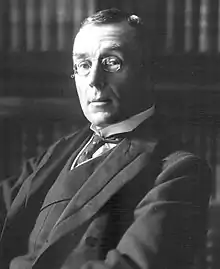John Meir Astbury
Sir John Meir Astbury (14 June 1860 – 21 August 1939) was a British judge and politician.[1][2]

Early life and career
Astbury was born at Grove House, Broughton, Salford, Lancashire, the son of Frederick James Astbury and Margaret née Munn.[1][2] His father was a chartered accountant from Hilton Park, Prestwich, and John was educated at Manchester Grammar School before entering the University of Oxford.[1][2]
He attended Trinity College, Oxford where he studied jurisprudence. He graduated with a second class degree in 1882, in the following year achieving a first class in the Bachelor of Civil Law examination.[1][2] In 1884 he was awarded the university's Vinerian Scholarship. This enabled him to enter the Middle Temple as a law student. He was called to the bar in the same year, and became a bencher in 1903.[1][2]
Astbury established a legal practice in Manchester, principally dealing with cases at the Palatine Chancery Court and at the Lancashire Assizes.[1][2] In 1895 he "took silk" to become a Queen's Counsel.[3] He moved to London, where he was attached to the courts of Sir Edmund Widdrington Byrne and Sir Henry Buckley successively.[1][2]
In 1905 he became a Chancery "special", charging an additional fee for his expertise in patent law. The choice proved wise, and he conducted a very profitable practice until 1913.[1][2]
Member of Parliament
At the 1906 general election Astbury was chosen by the Liberal Party to contest the Lancashire constituency of Southport. There was a large swing to the Liberals, and Astbury unseated the Conservative member of parliament, Edward Marshall Hall, a fellow barrister.[1][2] However, he had little interest in politics, and retired from the Commons at the next general election in January 1910.[2]
High Court judge
In 1913 Astbury was offered a vacant judgeship in the Chancery Division by the Lord Chancellor, Viscount Haldane. He accepted the position and was knighted.[1][4][5] He held the post for sixteen years, in what was generally considered an undistinguished manner.[1][2] He did, however, come to the notice of the public during the General Strike of 1926. His injunction on 11 May in favour of the National Sailors' and Firemen's Union of Great Britain was arguably instrumental in ending the strike on the following day.[1][2][6]
He resigned his seat on the bench in October 1929 and was made a Privy Councillor the same year.[2][7] Astbury had been made an honorary fellow of Trinity College in 1923 and on his retirement donated a large collection of legal textbooks and judgements to his alma mater.[2]
Family
Astbury was twice married. In 1888 he wed Evelyn Susmann, daughter of a Manchester merchant. Following her death in 1923 he married Harriet, widow of Captain Morrell Andrew Girdlestone and daughter of George Holmes of Philadelphia, United States. He had one child, a daughter from his first marriage, who died in a motor accident.[1][2]
Death
The last ten years of Astbury's life saw him struggling with blindness and the loss of his only child. He died at a hotel in Sandwich, Kent in August 1939 aged 79.[1][2]
References
- Landon, P A (2004). "Astbury, Sir John Meir (1860–1939)". Oxford Dictionary of National Biography. Oxford University Press. Retrieved 28 August 2011.
- "Obituary: Sir John Astbury". The Times. 23 August 1939. p. 7.
- "No. 26647". The London Gazette. 26 July 1895. p. 4233.
- "No. 28725". The London Gazette. 3 June 1913. p. 3911.
- "No. 28746". The London Gazette. 15 August 1913. p. 5866.
- The Legality of the General Strike in England A. L. Goodhart The Yale Law Journal, Vol. 36, No. 4 (Feb., 1927), pp. 464-485 Published by: The Yale Law Journal Company, Inc.
- "No. 33561". The London Gazette. 17 December 1929. p. 8181.
External links
- Hansard 1803–2005: contributions in Parliament by John Astbury
- Portraits of Sir John Meir Astbury at the National Portrait Gallery, London

| Parliament of the United Kingdom | ||
|---|---|---|
| Preceded by Edward Marshall Hall |
Member of Parliament for Southport 1906–1910 |
Succeeded by Godfrey Dalrymple-White |